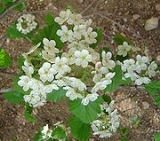
Downy Hawthorn
Encyclopedia
Crataegus mollis, known as Downy Hawthorn or Red Hawthorn, occurs in eastern North America
from southeastern North Dakota
east to Nova Scotia
and southwest to eastern Texas
. This tree inhabits wooded bottomlands, the prairie border, and the midwest savanna
understorey.
This tree grows to 10–13 m high with a dense crown of thorny branches and an ash-grey trunk. The leaves
are 5–10 cm in length and often drop in late summer due to defoliation by leaf diseases. The tree seems to suffer little from the early loss of its leaves. Among the earliest in the genus to bloom, Downy Hawthorn also has earliest ripening fruit, which decorate the defoliated tree in late summer and early fall. It is closely related to Crataegus submollis
, but the two species have separate native ranges. Amongst other differences between these two species, C. submollis has approximately 10 stamens, whereas C. mollis has approximately 20 stamens per flower.
The white flower
s are borne in clusters at the end of the branches in spring. The bright red edible fruit ripens in late summer and early fall and falls soon after.
This species is a target of Gypsy moth
s. Leaf rusts and fireblight
are among the many foliage diseases to affect this species. The sharp thorns are a hazard.
This species is uncommon in cultivation.
North America
North America is a continent wholly within the Northern Hemisphere and almost wholly within the Western Hemisphere. It is also considered a northern subcontinent of the Americas...
from southeastern North Dakota
North Dakota
North Dakota is a state located in the Midwestern region of the United States of America, along the Canadian border. The state is bordered by Canada to the north, Minnesota to the east, South Dakota to the south and Montana to the west. North Dakota is the 19th-largest state by area in the U.S....
east to Nova Scotia
Nova Scotia
Nova Scotia is one of Canada's three Maritime provinces and is the most populous province in Atlantic Canada. The name of the province is Latin for "New Scotland," but "Nova Scotia" is the recognized, English-language name of the province. The provincial capital is Halifax. Nova Scotia is the...
and southwest to eastern Texas
Texas
Texas is the second largest U.S. state by both area and population, and the largest state by area in the contiguous United States.The name, based on the Caddo word "Tejas" meaning "friends" or "allies", was applied by the Spanish to the Caddo themselves and to the region of their settlement in...
. This tree inhabits wooded bottomlands, the prairie border, and the midwest savanna
Savanna
A savanna, or savannah, is a grassland ecosystem characterized by the trees being sufficiently small or widely spaced so that the canopy does not close. The open canopy allows sufficient light to reach the ground to support an unbroken herbaceous layer consisting primarily of C4 grasses.Some...
understorey.
This tree grows to 10–13 m high with a dense crown of thorny branches and an ash-grey trunk. The leaves
Leaf
A leaf is an organ of a vascular plant, as defined in botanical terms, and in particular in plant morphology. Foliage is a mass noun that refers to leaves as a feature of plants....
are 5–10 cm in length and often drop in late summer due to defoliation by leaf diseases. The tree seems to suffer little from the early loss of its leaves. Among the earliest in the genus to bloom, Downy Hawthorn also has earliest ripening fruit, which decorate the defoliated tree in late summer and early fall. It is closely related to Crataegus submollis
Crataegus submollis
Crataegus submollis is a species of hawthorn that grows to about 10 m in height and typically carries large crops of red fruit.This species is closely related to C. mollis, but the two species have separate native ranges. Amongst other differences between these two species, C. mollis has...
, but the two species have separate native ranges. Amongst other differences between these two species, C. submollis has approximately 10 stamens, whereas C. mollis has approximately 20 stamens per flower.
The white flower
Flower
A flower, sometimes known as a bloom or blossom, is the reproductive structure found in flowering plants . The biological function of a flower is to effect reproduction, usually by providing a mechanism for the union of sperm with eggs...
s are borne in clusters at the end of the branches in spring. The bright red edible fruit ripens in late summer and early fall and falls soon after.
This species is a target of Gypsy moth
Gypsy moth
The gypsy moth, Lymantria dispar, is a moth in the family Lymantriidae of Eurasian origin. Originally ranging from Europe to Asia, it was introduced to North America in the late 1860s and has been expanding its range ever since...
s. Leaf rusts and fireblight
Fireblight
Fire blight, also written fireblight, is a contagious disease affecting apples, pears, and some other members of the family Rosaceae. It is a serious concern to producers of apples and pears...
are among the many foliage diseases to affect this species. The sharp thorns are a hazard.
This species is uncommon in cultivation.

